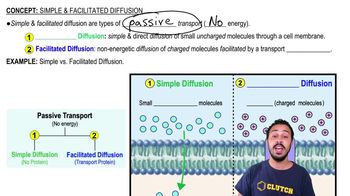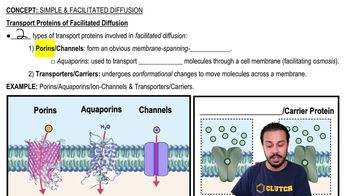Simple and Facilitated Diffusion definitions Flashcards
 Back
BackSimple and Facilitated Diffusion definitions
1/15
Terms in this set (15)
- DiffusionThe passive movement of molecules from an area of higher concentration to an area of lower concentration, requiring no energy.
- Facilitated DiffusionPassive transport process where molecules move down their concentration gradient via specific transmembrane proteins, without energy expenditure, typically for polar or charged substances.
- Passive ProcessMovement of molecules across a cell membrane without energy input, following the concentration gradient, either directly or via a transport protein.
- Concentration GradientThe gradual difference in the concentration of solutes in a solution between two regions, leading to the movement of particles from high to low concentration.
- Protein TransporterA membrane protein that facilitates the passive transport of polar or charged molecules across the cell membrane without using energy.
- Cell MembraneA selective barrier composed of a lipid bilayer with embedded proteins, regulating the entry and exit of substances, maintaining homeostasis, and facilitating communication between cells.
- Protein ChannelA membrane-spanning protein that facilitates the passive transport of specific molecules or ions across the cell membrane, following their concentration gradient without using energy.
- Lipid BilayerA double-layered structure forming the core of cell membranes, composed of hydrophobic tails and hydrophilic heads, regulating molecule passage based on polarity and size.
- NonpolarMolecules that lack a charge and do not have regions with partial positive or negative charges, allowing them to pass through the cell membrane via simple diffusion.
- HydrophobicRepels water and other polar substances, typically nonpolar molecules that do not mix with water.
- PolarMolecules with uneven distribution of electrical charge, making them hydrophilic and unable to pass through the cell membrane without a transport protein.
- Charged IonsIons with a net electric charge, either positive or negative, that cannot pass through the cell membrane via simple diffusion and require facilitated diffusion using transport proteins.
- HydrophilicAttracted to water, these molecules or substances interact well with water and other polar solvents, often requiring transport proteins to cross cell membranes.
- Calcium IonsPositively charged particles essential for various cellular processes, including muscle contraction, neurotransmitter release, and signal transduction, requiring facilitated diffusion to cross cell membranes.
- Sodium IonsPositively charged particles that cannot pass through the cell membrane via simple diffusion and require a transport protein for facilitated diffusion.


